![]()
![]()
![]()
Use LEFT and RIGHT arrow keys to navigate between flashcards;
Use UP and DOWN arrow keys to flip the card;
H to show hint;
A reads text to speech;
251 Cards in this Set
- Front
- Back
|
what were ancient reefs composed of
|
calcium carbonate
|
|
|
explain the evolution of reef builders
|
algae
archaeocyathids (sponge creatures) brachiopods |
|
|
microatolls
|
colonies of coral that grow on tropical reef flats
|
|
|
what are microatolls proxies for?
|
sea level change
|
|
|
evoloution of types of reefs
|
fringing- on the edge of an island
barrier- increasing distance atoll- when island subsides completely |
|
|
coral reef growth is controlled by what factors
|
tempature
salinity light nutrients exposure to dynamics sediment seawater carbonate chemistry |
|
|
what is the ideal salinity for corals?
|
34 to 36 ppt
|
|
|
what is the ideal temperature for coral reefs
|
25 and 29 degrees C
|
|
|
what is the average amount of nitrate and phosphate for coral reefs in order to thrive
|
less than 0.001 micromolar per L
|
|
|
What is the average argonite saturation for coral reefs
|
3.28
|
|
|
what is the average light penetration for coral reefs
|
9 m
|
|
|
what is the geographical extent of coral reefs
|
between 30 S and 30 N
|
|
|
what has lead to the ability of coral to adapt to being more tolerant to changes in heat or cooling
|
heat shock proteins that refold denatured proteins
antioxidant proteins deactivate toxi oxygen free radicals produced when corals are under thermal stress |
|
|
what does light enhance on coral reefs
|
photosynthesis and caco3 deposition
|
|
|
at what percent of light attenuation does coral growth rates start to significantly decrease
|
30 to 40 percent
|
|
|
how and N and P found in the sea water
|
dissolved org nitrogen
dissolved inorg nitrogen detritus |
|
|
In what forms is it most important to have N and P
|
nitrate and phosphate
|
|
|
what is crucial to the success of coral nutrient wise
|
nutrient recycling
|
|
|
what are ways that new nutrients can be added to coral systems
|
N fixation
upwelling geothermal endo-upwelling rainfall and terrestrial run off |
|
|
explain geothermal endo-upwelling
|
heat from geothermal activity changes the density of the water, upwelling nutrients from the bottom through the pores of the coral. Nitrogen fixing bacteria from the anoxic waters of the deep also help contribute as well
|
|
|
what is another nutrient that is important to coral life
|
iron
|
|
|
Hydrodynamics and exposure to wave action affect what in coral reefs
|
reef morphology
reef community structure sediment distribution patterns zones of early reef diagenesis larval transport pathways |
|
|
areas with high wave action: what type of coral dominates? for low wave action
|
low encrusting corals in the high energy wave areas
high encrusting corals in low energy |
|
|
how do corals affect wave energy
|
they absorb a lot of wave energy to protect reefs
|
|
|
sedmentation and microbial activity on reefs
|
sediments bring in more nutrients which increase microbial activity
|
|
|
sedimentation and coral access to light
|
sedimentation reduces light attentuation, which can reduce photosynthesis
|
|
|
sedimentation and coral larvae
|
depending on the coral species, some are more successful than others at riding of sedimentation. It can potentially reduce settlement
|
|
|
explain coral's dependency on concentrations of aragonite
|
if there is not enough saturation of caco3 in the water, then corals will not be able to lay deposits of calcium
|
|
|
endosymbiosis
|
living inside another organism
|
|
|
ectosymbiosis
|
living oustide another organism
|
|
|
obligate vs faculative symbiosis
|
obligate must live together
faculative can live independent |
|
|
three forms of symbiosis
|
parasitism
commensalism mutualism |
|
|
what has been seen to coexist with zoox and coral
|
cyanobacteria
|
|
|
Clade C of zoox are found
|
in normal conditions and mainly in the pacific
|
|
|
Clade B of zoox are found
|
mainly in the caribbean and in cooler conditions
|
|
|
Clade D zoox are found
|
in hotter conditions and in turbid waters
|
|
|
how is calcification enhanced
|
by the presence of sunlight and
by trans calcification |
|
|
explain the relationship between irradiance and amount of chlorophyll a in zoox
|
when irradiance decreases, the number of chlorophyll increases
|
|
|
how can zoox be used in radioisotopic labeling
|
zoox take up C14 which can be traced
|
|
|
what are some benefits of the zoox-coral relationship
|
autotrophy: capturing energy from the sun
Catching planktonic food and coral waste feed the zoox N conservation and recycling light enhanced calcification fixed place in water column protection for zoox detox of coral by zoox Supplementary O2 and CO2 |
|
|
fluorometry and corals
|
The excitement of cholorphyll passing on energy from the sun can be measured using a fluorometer
|
|
|
how do coral acquire nitrogen
|
DIN
DON PON from sediment plankton |
|
|
how are zoox given to new corals?
|
either through asexual budding
if it is done sexually, then it is absorbed from the surrounding sea water |
|
|
where do zoox come from?
|
healthy coral that expel zoox to keep their internal population regulated
unhealthy corals that are understress guts of zooplanktonic grazers that are eaten by coral waste food and wastes of larger organisms that eat coral |
|
|
how do microbiota, such as bacteria help coral
|
fix N, gather nutrients such as iron and P
some microbes could protect against pathogens |
|
|
who do sponges have symbiotic relationships
|
cyanobacteria, dinoflagellates, zoox, diatoms, green algae
|
|
|
what is a coral
|
an animal that eats and uses light
builds cacao3 and has symbiosis with zoox |
|
|
Life history of coral
|
settlement --> asex bud --> secrete skeleton --> reproduce by form gametes --> spawn/fert --> embryogenesis --> larval settlement
|
|
|
coral larvae
|
planulae
|
|
|
how does a planulae settle?
|
cilia move it and it detects chemical signals from other polyps and from substrate
|
|
|
how to coral get zoox
|
either from parents or from environment once settled
|
|
|
factors affecting coral settlement
|
rugosity
depth light biofilm caralline algae |
|
|
where do coral usually settle
|
on sides or under surfaces
|
|
|
CCA is a good indicator of?
|
a well grazed reef
|
|
|
which has a faster growth rate branching or massive corals
|
branching, but they are lighter
|
|
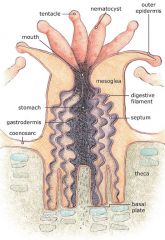
identify structures
|
coenosarc transports nutrients
gastrodermis epidermis calcifies at bottom costae radial stem of outerwall septae radia in wall |
|
|
SML
|
surface mucopolysaccharid layer
layer of microbes on coral that help build immunity |
|
|
how corals eat
|
suspension feeders
zoox products cilia creating microcurrents using active transport for eating POM |
|
|
3 types of cnidae
|
nematocysts
spirocysts ptychocysts |
|
|
hermatypic
|
coral w/ zoox
|
|
|
ahermatypic
|
w/o zoox
|
|
|
how much of coral food is produced by zoox
|
50 to 90
|
|
|
how do coral thrive in nutrient poor waters
|
nutrient recycling between zoox and coral
constant flow of low nutrients inputs from land from storms |
|
|
what are the main resources that coral compete for
|
light and nutrients
|
|
|
how do branching coral outcompete
|
the grow over the top
|
|
|
what are other mechanisms for outcompeting
|
allelopathy
have epifauna that live inside and will protect each eat other sweeper tentacles overgrowing |
|
|
Porifera
|
sponges
|
|
|
Cnidaria
|
jellyfish hydroids and corals
|
|
|
Ctenophora
|
jellies w/o nematocysts
|
|
|
annelida
|
segmented worms
christmas tree worms feather duster worms |
|
|
mollusca
|
snails, bivales, squid, octopus, conch, oyster
|
|
|
arthropoda
|
crustaceans, insects, anemones, barnacles
|
|
|
ectoprocta
|
bryozoans
usually found on floating objects or in crevacess |
|
|
echinodermata
|
spiny skin
urchins, sea cucs, sea stars, brittle stars |
|
|
chordata
|
turnicates
sea turtles fish eels |
|
|
kingdom plantae
|
plants
|
|
|
magnoliophyta
|
sea grass
|
|
|
rodophyta
|
red algae
wrangelia ramicrusta acanthophora |
|
|
chlorophyta
|
green algae
|
|
|
phaeophyta
|
brown algae
dictyota turbinaria sargassum |
|
|
name some importances to reef algae
|
coralline algae binds reefs
algae crest can reduce wave energy calicifying leads to sand |
|
|
what algae are harmful
|
microalgal turf (no coral settling)
macroaglae that overgrow |
|
|
beneficial algae
|
CCA
|
|
|
bottom up v top down
|
bottom up resources regulate
top down reg by predators |
|
|
According to Littler and Littler, what happens to algae/reef with low human impact but high nutrients?
|
it will lead to an increasing presence of CCA
|
|
|
According to Littler and Littler, what happens to algae/reef with high human impact and high nutrients?
|
Increase of frondose macroalgae overgrowth
|
|
|
According to Littler and Littler, what happens to algae/reef with high human impact but low nutrients?
|
lots of turf algae
|
|
|
According to Lapointe, what is the nutrient level threshold for reefs
|
1.0 micromoles of DIN
0.1 micromoles of SRP |
|
|
What did Smart argue was the biggest threat to reefs
|
decreasing herbivores that keep algae in check.
|
|
|
What did Hughes et al show about algae and herbivores
|
that herbivores significantly impact the presence of algae
|
|
|
what did littler argue about nutrients, algae and herbivores
|
low nutrients does not mean that you are not going to have algae and that you can even have a lot of algae with lots of herbivores
|
|
|
3.5 bya what kinds of coral existed
|
stromatolites
cyanobacteria would bind sediments |
|
|
560 mya what kinds of coral existed
|
Archaeocyantha which were sponge like animals that bound particulate together
|
|
|
250 mya what kinds of coral exists
|
first schleractinian corals with zoox
|
|
|
trilobites
|
ancient orgs look like skates hat are extinct
|
|
|
petosky stones
|
fossilized coral
|
|
|
why is there not coral on western boundaries of nations?
|
because of upwelling
|
|
|
where is the highest biodiversity
|
indopac
|
|
|
where is the lowest biodiversity
|
east pacific and atlantic
|
|
|
what do corals need to grow
|
light
nutrients temperature space (hard substrate) salinity (34 to 36) hydrology minimal sedimentation minimal emergence into the air |
|

|
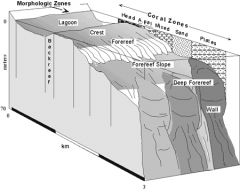
|
|
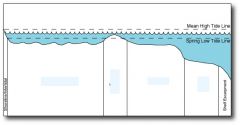
|

|
|
|
what types of coral are typically found in shallow areas with wave action
|
acropora
porites diploria |
|
|
mid reef corals
|
montastrea
colpophyllia diploria |
|
|
deep reef corals
|
agaricia
black coral |
|
|
3 types of coral reefs
|
fringing-right next to
barrier- increased distance from shore with deep and larger area atoll- volcano has ceded into the ocean |
|
|
what happened to the sea as a result of pangea breaking up
|
lead to the creation of endemic biota
|
|
|
what happend to the sea as a result of the isthmus of panama forming
|
the channel which once allowed larval transport from the east to the west lead to local extinction in the east pacific
|
|
|
Where is most larval replacement occurring from in present day east coast pacific
|
western pacific
|
|
|
what are macroscale processes affecting coral reef location/type
|
tectonic activity
sea level |
|
|
mesoscale processes that affect coral reef location/type
|
temp
salinity wave energy from storms and currents |
|
|
microscale processt that affect coral reefs
|
light
nutrients sediments prior topography |
|
|
meiosis
|
short version: production of gametes
|
|
|
gonochorism
|
separate sexes
|
|
|
broadcast spawning vs brooding
|
brooders- fert takes place inside of maternal polyp
spawners-release gametes into the water column |
|
|
larval disp: broadcast v brooding
|
brooder lower than spawners because they are more developed
|
|
|
dispersal patterns of broadcast v brooder
|
brooder go farther because they are more developed
|
|
|
genetic variability broadcast v brooder
|
spawners more diversity
|
|
|
# times of year brooder v spawning
|
brooder 1 mo
spawn 1 to 2 times a yr |
|
|
# of larvae brooder v spawner
|
brooder less than spawn
|
|
|
timing of coral spawning
|
1 week after full moon
warmest T |
|
|
what are the two ways of asexual spawning/growth for coral
|
budding and fragmenting
|
|
|
gemmae
|
asexual bud of soft tissue from parent colony
|
|
|
define disease
|
any impairment of the vital body functions, systems or organs
|
|
|
paraite
|
nut ben from host
|
|
|
pathogen
|
leads to the death of host
|
|
|
epizootic
|
increased breakout in organisms affected
|
|
|
what are defense mechanisms corals have against disease
|
mucus, produce antibiotics and alleopathy, protective epidermis, amoeboid cells that engluf pathogens
|
|
|
fibropapillomas
|
sea turtle tumors
|
|
|
causes of disease
|
water flow
storms sediment pollution temp change |
|
|
how does pollution affect coral in the short term
|
corals can survive by using mucus to take it off.
sediment can change the larval sense of the reef |
|
|
how does pollution affect coral in the long term
|
no reuptake of zoox
biaccumulation decreased coral growth, repro, death, trophic cascades |
|
|
how can you identify an infectious disease on a coral
|
lesions or band of tissue loss
|
|
|
how do infectious diseases affect coral
|
decrease in tissue, growth, and reproduction
change in diversity |
|
|
which area is a hot spot for diseases
|
caribbean
|
|
|
what are zoox
|
unicellular dinoflagellates
|
|
|
how many zoox do coral have
|
1-2 milition be square cm
|
|
|
explain amount of zoox in between deep
|
deep zoox are more heterotrophs than they are autotrophs
|
|
|
What is the ratio between photosynthesis and respiration for an autotroph? a heterotroph?
|
P:R > 1 autotroph
P:R < 1 heterotroph |
|
|
How many species of coral are there
|
17
|
|
|
Clade A
|
like a weed
very hardy and opportunistic |
|
|
Clade B
|
does not produce sunscreen to cover corals
|
|
|
rebrowning
|
when a coral reacquires its zoox
|
|
|
adaptive bleaching hypothesis
|
bleaching is a process of coral adapting to a new environ and being able to acquire new zoox that are better for the new environ
|
|
|
coral mechanisms to resist bleaching
|
heat shock proteins
oxidating enzymes dissipating light changing ratio of zoox clades |
|
|
explain ratio of chlorophyll a in relation to deep and shallow coral
|
deep have more than shallow
|
|
|
MAAs
|
sunscreen for corals against UV
|
|
|
how do chromatophores help coral
|
they change the wavelength of light
|
|
|
how does photosynthesis increase calicification
|
it removes phosphate which inhibits calicification
it also removes carbon dioxide which drives the formation of calicium carbonate |
|
|
what degree change in T can cause bleaching
|
1
|
|
|
does light help calcification
|
yes because photosynthesis removal of co2 helps drive it
|
|
|
how does having zoox cost corals
|
restricted to photic zone
need defense against high light and oxygen toxicity must have vacuole for zoox |
|
|
identify the pros and cons for the coral-zoox relationship for zoox
|
good: receives N and P, access to light, carbon dixoide, protection from grazers,
costs: risk evacuation, must give in order to tay, nutrient limited growth rates |
|
|
how many of the ocean organisms can bioluminesce
|
90%
|
|
|
how do coral benefit from zoox
|
nutrients/sugars
increased growth and reproduction chemical wastes are removed receive chemicals to prevent UV damage oxygen from zoox |
|
|
what is the purpose of bioluminescence
|
mating
communication protection lure prey |
|
|
4 Fs
|
fleeing
feeding fighting flirting |
|
|
What is the reaction that makes bioluminesce
|
luciferin + o2 --> luciferase --> oxyluciferin and light
|
|
|
what is bioluminescence found in
|
fungi, bacteria, animals, algae, jellyfish, etc
|
|
|
what type of radiation do shrimp on hydrothermal vents detect
|
IR radiation
|
|
|
what is fluorescence
|
chromatophores reemit light when electrons move to a lower energy level
|
|
|
what is the purpose of fluorescence
|
medicine, geology, genetics, detergent, crime scence, water flow, locating coral recruits
|
|
|
holoplankton
|
planktonic all life
|
|
|
meroplankton
|
planktonic part of life
|
|
|
what are problems for plankton
|
sinking
predation finding food |
|
|
what are plankton solutions to problems
|
osmosis
gas/oil sacs following convection SA/V ratio |
|
|
diel migration
|
zoop moving up in the water column at night
why? avoid predators |
|
|
how do zoop find food
|
chemofac
detect motion have net to capture food muscus net |
|
|
what is the importance of phytop
|
food source
prim prod o2 inc co2 dec microbial loop |
|
|
what limits phytop
|
light and nutr
|
|
|
biological pump
|
phytoplankton fix carbon, respire, are eaten, turn into detritus. C is transported to bottom if it is not remineralized from detritus.
|
|
|
dinoflagellates: auto or heterotrophs?
|
both. Zoox are autotrophs
|
|
|
diatoms
|
single celled organisms made of silica that can make antibodies
|
|
|
coccolithophores
|
caco3
found in fossil record respond to acidity |
|
|
CCD
|
calcite compensation depth
the depth @ which caco3 is dissolved faster that it is deposited below that depth caco3 is dissolved, above it its deposited. If the sea bed is above the CCD, then there can be calcaerous oozes found on the sea floor. |
|
|
silicous deposits increase with....
|
increasein p and decreasing t
|
|
|
is silica found below the CCD
|
yes, because it is not affected by the CCD.
|
|
|
copepod phylum
|
athropoda
|
|
|
what is the oceans largest source of protein
|
copepods
|
|
|
what factors affect survivorship
|
food availability
predator abundance oceanic conditions |
|
|
match mismatch hypothesis
|
recruiment success is related to the overlap of temporal/spatial overlap of larvae and their food source. if there is more overlap then ther eis more success
|
|
|
critical period hypothesis
|
if food is available after a larvae loses its yolk sac --> survival
and vice versa |
|
|
stable ocean hypothesis
|
a stable ocean leads to an incease in survivorship
|
|
|
why do organisms have a planktonic phase?
|
dispersal
genetic mixing escape predation leave adult population potential to find a better habitat |
|
|
what adds to the size of a population
|
recruitment
immigration growth of individuals |
|
|
what takes away from a population size
|
emigration
natural causes anthropogenic effects fisheries |
|
|
describe different factors that affect larval dispersal and recruitment
|
physical oceanography
biologial factors (length of larval phase, swimming ability, sensory abilities, interaction w/ sediment) olfaction hearing vision magnetism |
|
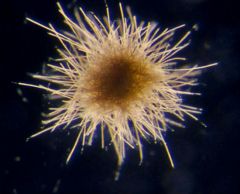
|
trichodesmium
|
|
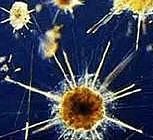
|
radiolaria
|
|
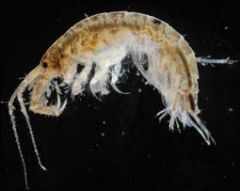
|
amphipod
|
|
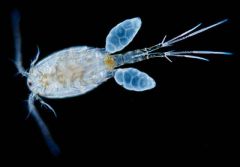
|
copepod
|
|
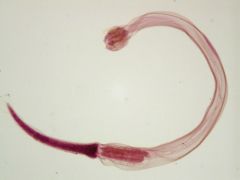
|
chaetognath
|
|
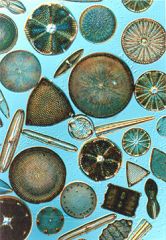
|
diatom
|
|

|
dinoflagellate
|
|

|
naupilus
|
|

|
tintinnid
|
|
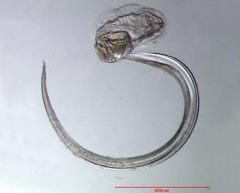
|
larvacean
|
|
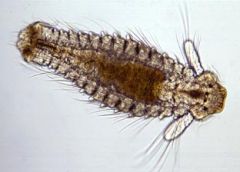
|
polychaete worm larvae
|
|
|
what way do the tradewinds flow
|
east to west
|
|
|
what way do the westerlies flow
|
west to east
|
|
|
what way do the easterlies flow
|
east to west
|
|
|
coriolis effect
|
free floating bodies over the earth appear curved in relation to an observer on the earth
R in N L in S |
|
|
hurricanes
|
area of low pressure where air is traveling towards
|
|
|
what way does a hurricane spin
|
CClock in N
Clock in S |
|
|
Ekman spiral
|
water stressed by wind is deflected 45 @ surface for a net 90 degree transport in the way of coriolis
|
|
|
direction of spin of gyres
|
Clock in N
CClock in S |
|
|
what is the global conveyor belt driven by
|
changes in temp and salinity
|
|
|
spring tide
|
align moon and sun
|
|
|
neap tides
|
weaker tides when moon and sun are @ 90 degree angles to each other
|
|
|
amphidromic points
|
no tidal fluccuation
|
|
|
remember upwelling and el nino
|
done
|
|
|
oceanic zones
|
epipelagic
mesopelagic bathypelagic abyssalpelagic hadalpelagic photic disphotic aphotic |
|
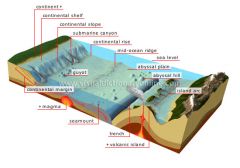
|
know this
|
|
|
avg depth of ocean
|
4000 ft
|
|
|
continental or ocean crusts heavier
|
oceaniic
|
|
|
caribbean plate formation
|
igneous
as the alt ocean spread the pacific ocean crust subducted under the caribbean plate |
|
|
how will climate change affect reefs
|
bleaching
acidification change sal and t sedimentation nutrients storms increase algae increase water rise |
|
|
oxygen isotopes and climate change
|
O18 is more abundant when there is an increase in T
1/1000 change in o18 = change 4 degree C |
|
|
What is the predicited changein T by the IPCC
|
1.1 to 6.4 degree C
|
|
|
ocean sea level rise occurs because
|
of thermal expansion and ice melting
|
|
|
ocean acidification
|
increase in dissolved co2 eventually leads to an increase in carbonic acid, which scavenges carbonate from corals, and evnetually creates bicarbonate and h+
|
|
|
how many years ago did modern reef fish arise
|
200 mya
|
|
|
what affects fish diversity on a single reef
|
hydrodynamics
zonation 3-D nature |
|
|
how is modern reef fish diversity seen
|
in color
|
|
|
why are fish colored
|
to signal to each other
UV sensitively to find food reproduction warning for venom camoflauge |
|
|
what is a good color for camoflague
|
red
|
|
|
batesian mimicry
|
mimicing a harmful orgs, but the mimic is not harmful
|
|
|
mullerian mimicry
|
look the same and are both harmful
|
|
|
are families an indicator of food preference?
|
no
|
|
|
energy efficiency and fish populations
|
where energy is devoted depends on your life phase
younger devote to growth and feeding older devote it to reproduction |
|
|
r selection
|
occurs in unstable environments where organisms are density independent
small organisms energy used to make indiv is low high fecundity early maturity and low life expectancy each individual repros once |
|
|
k selection
|
stable environment where orgs are density dependent
larger orgs engery to make indiv is high low fecundity late maturity and long life history repro more than once |
|
|
reproductive strategies of cartilagenous fishes
|
k selection
internal fertilization low fecundity |
|
|
reproductive strategies of bony/telost fishes
|
r selection
high fecundity external fertilization bipartite life cycles for young |
|
|
oviparity
|
lay/spawn eggs (int/ext)
|
|
|
aplacental viviparity
|
internal development, nourished by yolk sac, undv eggs, or siblings
ex: skates |
|
|
viviparity
|
placental connection and internal growth inside mother
ex: lemon shark |
|
|
Limiting factors for fecundity (m and f)
|
m: # mates
f: # of eggs |
|
|
Why change sexes
|
male fecundity is larger when they are smaller, where females are more fecund when they are larger. As a fish grows, it makes more sense for it to change sexes for higher fecundity
|
|
|
protandry
|
male --> fem
|
|
|
protogyny
|
fem --> male
|
|
|
What is the early life history of organisms in the caribbean
|
pelagic early life phases that are short
decrease mortality with increasing size early life orgs are larger in Carib than in temperate environs |
|
|
What would lead to larval mortality
|
unfavored env conditions
predation can't find habitat starve comp for resources |
|
|
recruitment
|
# of indiv that reach a specific life state (typically metamorphosis)
|
|
|
What is the purpose of pulses of recruitment
|
to avoid predation
|
|
|
Why is it difficult to study movement and habitat use?
|
a lot of spaces are inaccesible because they are too small
also things occur over large spanses |
|
|
What are barriers to global larval dispersal
|
isthmus of panama, thethys seaway, pacific ocean
|
|
|
Why should we study habitat use
|
understand ecological role on reefs, understand driving forces, distribution patterns, population dynamics, fisheries and conservation
|
|
|
How do scientists study movement of fish
|
visual surveys
fisheries data remote sensing genetic tags |
|
|
What 3 types of movement are there in sea orgs
|
spatial
temporal ontogenetic |
|
|
What are some generalizations about marine orgs and their activity spaces and home ranges
|
activity spaces increase with increasing size
smaller fish have smaller home ranges |

